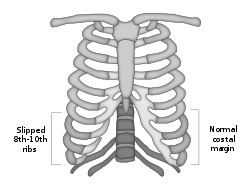Slipping rib syndrome

Editor-In-Chief: Prab R Tumpati, MD
Obesity, Sleep & Internal medicine
Founder, WikiMD Wellnesspedia &
W8MD medical weight loss NYC and sleep center NYC
| Slipping rib syndrome | |
|---|---|

| |
| Synonyms | Rib-tip syndrome, Clicking rib, Displaced rib cartilage |
| Pronounce | N/A |
| Specialty | Orthopedics, Rheumatology |
| Symptoms | Chest pain, Upper abdominal pain, Back pain, "popping" or "clicking" sensation |
| Complications | N/A |
| Onset | Any age, but more common in adults |
| Duration | Can be chronic or intermittent |
| Types | N/A |
| Causes | Hypermobile rib cartilage, trauma, repetitive motion |
| Risks | Athletes, Trauma, Hypermobility |
| Diagnosis | Physical examination, Hooking maneuver, Ultrasound, MRI |
| Differential diagnosis | Costochondritis, Tietze syndrome, Intercostal neuralgia |
| Prevention | N/A |
| Treatment | Physical therapy, Pain management, Surgery |
| Medication | NSAIDs, Analgesics |
| Prognosis | Generally good with treatment |
| Frequency | Rare |
| Deaths | N/A |
Slipping rib syndrome is a medical condition where the ribs move out of their normal position, causing pain in the thoracic or abdominal region. This condition is also known as rib tip syndrome, twelfth rib syndrome, clicking rib, rib subluxation, or traumatic intercostal neuritis.
Symptoms[edit]
The main symptom of slipping rib syndrome is persistent pain in the lower chest or upper abdomen. This pain can be sharp, dull, or aching, and it may be accompanied by a clicking or popping sensation. Other symptoms can include difficulty breathing, discomfort when bending or twisting, and tenderness in the affected area.
Causes[edit]
Slipping rib syndrome can be caused by a variety of factors. These include physical trauma to the chest or abdomen, hypermobility of the ribs, degeneration of the cartilage or ligaments that hold the ribs in place, and certain medical conditions such as fibromyalgia or chronic fatigue syndrome.
Diagnosis[edit]
Diagnosis of slipping rib syndrome can be challenging, as the symptoms can mimic other conditions such as gallbladder disease, ulcers, or heart disease. Diagnosis typically involves a physical examination, during which the doctor may perform the hooking maneuver to reproduce the symptoms. Imaging tests such as X-rays, CT scans, or MRI scans may also be used to rule out other conditions.
Treatment[edit]
Treatment for slipping rib syndrome typically involves conservative measures such as pain management, physical therapy, and lifestyle modifications. In severe cases, surgical intervention may be necessary to reposition the displaced rib.
Slipping_rib_syndrome images[edit]
-
Anatomy of the ribs
-
Model demonstrating the hooking maneuver for slipping rib syndrome
See also[edit]
References[edit]
<references />
Ad. Transform your life with W8MD's Budget GLP-1 injections from $75


W8MD offers a medical weight loss program to lose weight in Philadelphia. Our physician-supervised medical weight loss provides:
- Weight loss injections in NYC (generic and brand names):
- Zepbound / Mounjaro, Wegovy / Ozempic, Saxenda
- Most insurances accepted or discounted self-pay rates. We will obtain insurance prior authorizations if needed.
- Generic GLP1 weight loss injections from $75 for the starting dose.
- Also offer prescription weight loss medications including Phentermine, Qsymia, Diethylpropion, Contrave etc.
NYC weight loss doctor appointmentsNYC weight loss doctor appointments
Start your NYC weight loss journey today at our NYC medical weight loss and Philadelphia medical weight loss clinics.
- Call 718-946-5500 to lose weight in NYC or for medical weight loss in Philadelphia 215-676-2334.
- Tags:NYC medical weight loss, Philadelphia lose weight Zepbound NYC, Budget GLP1 weight loss injections, Wegovy Philadelphia, Wegovy NYC, Philadelphia medical weight loss, Brookly weight loss and Wegovy NYC
|
WikiMD's Wellness Encyclopedia |
| Let Food Be Thy Medicine Medicine Thy Food - Hippocrates |
Medical Disclaimer: WikiMD is not a substitute for professional medical advice. The information on WikiMD is provided as an information resource only, may be incorrect, outdated or misleading, and is not to be used or relied on for any diagnostic or treatment purposes. Please consult your health care provider before making any healthcare decisions or for guidance about a specific medical condition. WikiMD expressly disclaims responsibility, and shall have no liability, for any damages, loss, injury, or liability whatsoever suffered as a result of your reliance on the information contained in this site. By visiting this site you agree to the foregoing terms and conditions, which may from time to time be changed or supplemented by WikiMD. If you do not agree to the foregoing terms and conditions, you should not enter or use this site. See full disclaimer.
Credits:Most images are courtesy of Wikimedia commons, and templates, categories Wikipedia, licensed under CC BY SA or similar.
Translate this page: - East Asian
中文,
日本,
한국어,
South Asian
हिन्दी,
தமிழ்,
తెలుగు,
Urdu,
ಕನ್ನಡ,
Southeast Asian
Indonesian,
Vietnamese,
Thai,
မြန်မာဘာသာ,
বাংলা
European
español,
Deutsch,
français,
Greek,
português do Brasil,
polski,
română,
русский,
Nederlands,
norsk,
svenska,
suomi,
Italian
Middle Eastern & African
عربى,
Turkish,
Persian,
Hebrew,
Afrikaans,
isiZulu,
Kiswahili,
Other
Bulgarian,
Hungarian,
Czech,
Swedish,
മലയാളം,
मराठी,
ਪੰਜਾਬੀ,
ગુજરાતી,
Portuguese,
Ukrainian




